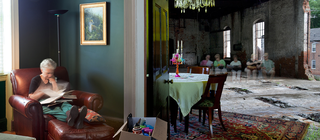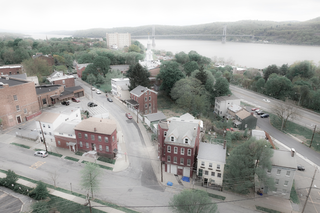An Artist, First and Foremost
Beacon Stories
Allen has always wanted to be known as an artist, first and foremost. His photography hints at the ever-changing nature of people’s lives and their environment, much like his own progression with retinitis pigmentosa (RP).
Allen Bryan’s photography is known to hint at the ever-changing nature of people's lives and their environment, much like his own progression in life. But this 75-year-old Hudson River Valley resident didn’t get to this place in his art career overnight.
Since a very young age, Allen was encouraged by his parents to pursue his passion for the visual arts. For many years after college, Allen was an art teacher. But after attending an American Craft Show with his wife, Ann, they became inspired to become full-time jewelry designers and goldsmiths. In order to promote their work, Allen taught himself to photograph the products, creating a dual career for himself, photographing other exhibitors at shows as well.

An example of Allen Bryan’s work.
Then, when he was 33 years old, Allen received some life altering news at a routine visit to the eye doctor. His optometrist did a “double take” during the exam and, after further investigation, told Allen it appeared he had a genetic disease called retinitis pigmentosa (RP). He explained the disease as his rods looking “like a bunch of dead flies,” and stated that Allen could go blind at any time.
After digesting this shocking news, Allen decided he wanted to travel, while he still had his vision, to see the vast landscapes of the country’s Southwest. While visiting Arizona, Allen instantly became interested in landscape photography. He continued to travel and photograph landscapes for many more years.
About 15 years after his initial diagnosis, Allen noticed his vision diminishing more drastically. It was then that Allen decided to stop driving and hasn’t driven himself since.

An aerial photograph by Allen Bryan.
“With limitations of driving myself, being a landscape photographer grew tough,” says Allen. “So, I started walking around my neighborhood taking pictures to stay busy. I was only able to see in small sections, but this started a whole new chapter of photography for me.”
The photographs shown in Allen’s work now are digitally constructed from slides of his older work combined with his new images, creating a very personal body of work. Allen has exhibited these photographs in galleries at prestigious institutions like the Smithsonian and The Kennedy Center.
“As my vision diminishes, I ironically have become a better photographer,” says Allen. “Having RP just slows down the way I work, but it’s really opened up a whole new way of working, giving me a unique perspective compared to other artists.”
To find out exactly what was causing his RP, Allen joined the Foundation’s My Retina Tracker Registry. He received genetic testing and discovered his RP is caused by mutations in the USH2A gene, as well as the RBP3 gene. Allen learned he’s in the 4.5% that has no hearing loss connected with USH2A mutations.
“The research is reassuring,” says Allen. “Everyone should be proactive in getting genetic testing and looking to enroll in clinical trials.”
Allen has also adapted in his day-to-day life by using a white cane. But using a cane was a big step for him, as he doesn’t necessarily prefer other people to have that as a first impression of him.
“I never want to tell a client upfront that I’m a legally blind photographer,” says Allen. “I don’t want to be known as a disabled artist. Yes, I’m an artist, and yes, I have a disability, but I’m an artist first.”
To view Allen’s photography, visit: www.allenbryan.com




